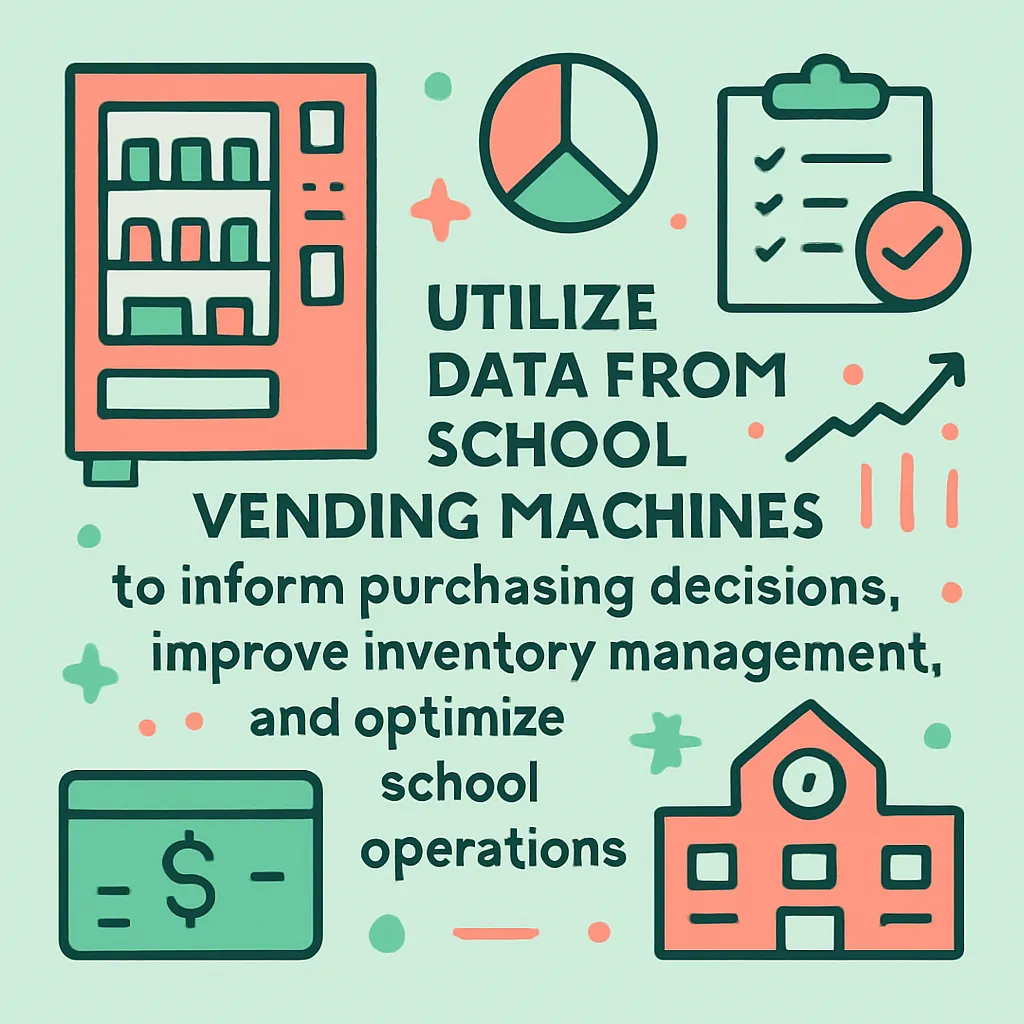Leveraging Vending Data for Smarter School Operations
Utilize data from school vending machines to inform purchasing decisions, improve inventory management, and optimize school operations.
Back to Vending for Schools ResourcesUtilize data from school vending machines to inform purchasing decisions, improve inventory management, and optimize school operations.
Back to Vending for Schools ResourcesModern school vending machines are more than just snack dispensers; they are rich sources of operational data. Discover how this valuable information can streamline your school's purchasing, enhance inventory efficiency, and boost student satisfaction.
![]() Optimize product selection based on real student preferences
Optimize product selection based on real student preferences
![]() Streamline inventory to reduce waste and ensure popular items are stocked
Streamline inventory to reduce waste and ensure popular items are stocked
![]() Identify peak usage times and locations for strategic machine placement
Identify peak usage times and locations for strategic machine placement

In today's interconnected educational environments, every operational aspect can be optimized through data analysis. School vending machines, often seen as simple conveniences, actually provide a wealth of information that can significantly enhance school operations. By collecting and interpreting vending machine data, schools can make more informed decisions about everything from product selection and inventory management to promoting healthier choices among students.
One of the most immediate benefits of leveraging vending data is the ability to fine-tune product offerings. Analytics reveal which items are best-sellers and which ones linger on the shelves. This insight allows schools to stock more of what students actually want, reducing waste and maximizing satisfaction. For example, if data shows a high demand for protein bars in the morning, the school can ensure these are always available. Conversely, slow-moving items can be phased out or replaced with new options, ensuring that machines are always offering relevant products.
Effective inventory management is another critical area where vending data shines. With real-time sales reports, schools can precisely track stock levels. This eliminates guesswork, minimizes the risk of running out of popular items, and prevents overstocking that can lead to spoilage or expiration, particularly for fresh food items. This proactive approach ensures operational efficiency and a consistently positive user experience. For further guidance on maintaining optimal stock, consider reviewing resources on snack and beverage programs for schools.
Vending data can be a powerful ally in promoting student wellness. By analyzing purchasing patterns, schools can observe the demand for healthy versus less healthy options. This information can then be used to strategize placement of more nutritious items, or to introduce new healthy choices that align with student preferences. Understanding these trends helps schools comply with healthy snack policies and support broader nutritional goals. More on this topic can be found by exploring healthy snack policy for schools.
Beyond products, vending data indicates when and where machines are most frequently used. This spatial and temporal analysis helps schools optimize machine placement. For instance, a machine near the athletic facilities might sell more sports drinks in the afternoon, while one in the library might see higher coffee sales during exam periods. Such insights ensure machines are conveniently located and performing optimally, meeting student and staff needs without interruption. Details on optimal machine types and placement can be found in discussions about best vending machine types for schools.
In conclusion, treating school vending machines not just as equipment but as data collection points can provide invaluable insights for school administrators. By embracing these analytics, schools can create more efficient, responsive, and student-centric vending programs that contribute positively to the overall campus environment.
School vending machines can provide data on popular products, sales times, inventory levels, and payment methods used by students and staff.
By analyzing sales data, schools can identify top-selling items and less popular options, optimizing future orders to stock more of what students want and less of what doesn't sell.
Yes, real-time sales and inventory data allow schools to manage stock efficiently, preventing shortages of popular items and reducing waste from expired products.
Absolutely. Data can highlight demand for healthy options, guiding schools to stock more nutritious snacks and promoting healthier eating habits among students.
Modern vending systems use secure networks for data transmission, ensuring that sales and inventory information is protected and compliant with privacy standards.
Data is typically accessible through a secure online portal or reporting dashboard provided by the vending service, offering insights into machine performance.
Real-time data allows for immediate adjustments to inventory, pricing, and product placement, maximizing sales and operational efficiency.
By understanding when and where peak sales occur, schools can strategically place machines in high-traffic areas to meet demand and improve accessibility.
Yes, analysis of purchase data can show evolving student preferences, helping schools adapt offerings to changing tastes and dietary trends.
By ensuring popular items are always in stock and offering desired product selections, data-driven vending enhances student satisfaction and convenience on campus.